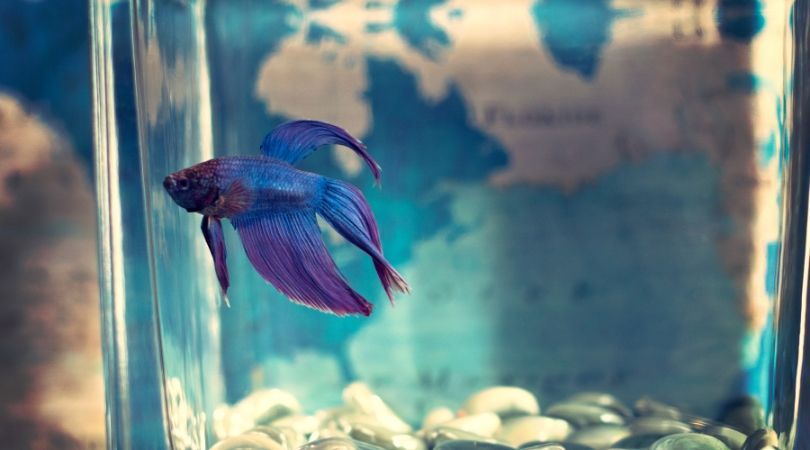Fishkeeping has been on the rise over the years. An aquarium (and pet fish) are a beautiful addition to any home.
So, how can you create and maintain an aquarium is beautiful, yet energy-efficient and eco-friendly? In general, it’s best to be minimalist and simple with the aquarium and fish that you purchase.
In this article, we’ll 7 ways to start and maintain an eco-friendly fish tank.

1. Think Small
If you are new in the field of fishkeeping it’s always best to start small. Smaller and fewer fish means smaller aquariums, and this means that less energy will be needed to power your lighting, filtration, and heating systems.
It’s also much easier to learn the basics of fishkeeping with smaller fish and smaller aquariums.
When talking about aquarium size, however, it’s important that you DO NOT buy a fish bowl, as these are often more difficult to maintain and unhealthy for your fish.
There are, however, some fish that do thrive in smaller tanks of 5 to 10 gallons, like guppies or betta. We’ll talk more about choosing fish later.
2. Don’t Overdo when it comes to plants
I don’t dispute the fact that aquatic plants are a great way of decorating your aquarium. You should note, however, that having more plants means you’ll need to use more energy to power the lighting that keeps those plants alive.
So, if you want to keep your energy consumption on the low-end, then consider using plastic plants or decorations instead of live plants (or in conjunction with live ones).
3. Use LED Lighting
LED lights are a lot more energy-efficient than traditional aquarium light systems, which means that they’ll be better for your wallet and better for the environment.
Just make sure that you do your own research before buying LED lights for your aquarium, as some fish or plants require their own special type of lighting.
4. Heating System
Heating is essential for almost every species of fish, as they all prefer their own specific water temperature. For example, bettas (a common fish for small tanks) prefer a water temperature of around 78-80 degrees fahrenheit.

When buying an aquarium heater, make sure to buy one with an appropriate wattage for your tank’s size. It must be powerful enough to consistently heat your entire tank and ensure that your fish remain happy.
You should also consider moving your fish tank away from windows in the winter (if you live in a colder climate) so that less heat is lost from the aquarium.
5. Tank Filters
Most aquariums will need to have a filter running 24/7 to maintain clean water quality for your fish.
So, how can you increase the energy efficiency of your aquarium through your filter?
Well, when you buy your filter, get one that is rated appropriately for the size of your tank. For example, if a filter is rated for a 40 gallon tank, you shouldn’t buy it for a small 10 gallon tank.
Because a filter is always running, a smaller filter means more energy efficiency (in general), which means more energy-savings and a more environmentally-friendly aquarium.
Apart from the filters, I also recommend conducting partial water changes every-so-often.
6. Avoid Salt-Water Fish
In general, salt-water fish are harder to care for and are much more expensive to care for than freshwater fish.
In general, saltwater fish are more demanding than freshwater fish, and their aquariums require more energy to maintain. Thus, they aren’t as eco-friendly as freshwater aquariums.
7. Plan ahead (so that your pet fish doesn’t outgrow your aquarium)
Always ensure that you know the fish breeds that you are purchasing. Some species can grow a lot from when they are babies to when they become adults. You’ll want to plan ahead so that the aquarium you buy is big enough to last your fish their entire lifetime.
Having to buy a new aquarium not only means that you’ll have to spend more money, but you’ll also be adding to unnecessary consumption and consumerism that is harming our environment.
Here are some important pointers if you’re buying your first fish:
- Do NOT mix up fish that aren’t meant to live together. You should always stock compatible fish.
- Avoid purchasing endangered species
- Always purchase from authorized dealers
- Use natural corals or stones
- Be humane when handing the fish and while feeding them
- Always remember that taking care of the fish is most important. If you won’t be able to properly take care of it, don’t buy it!
8. Consider a self-sustaining aquarium
A self-sustaining aquarium is an aquarium that can sustain itself. This means that all the organisms inside the aquarium are able to survive on their own (for the most part), without the constant care of a person.
Self-sustaining aquariums usually don’t require the use of a filter, so they will be more energy-efficient in that regard. However, they will still need proper lighting, and potentially an aquarium heater if you plan to keep more tropical fish.
This post was kindly sponsored by The Aquarium Guide




